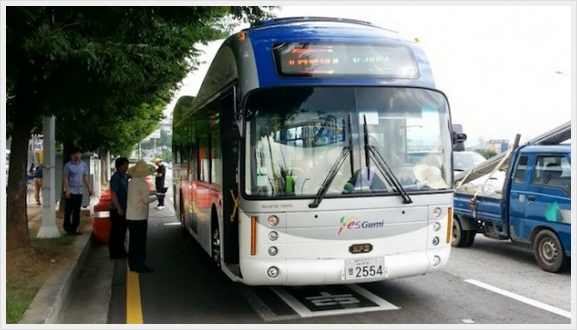
Photo: KAIST
South Korea unveils buses which charge from roads
12 June 2014
by Richard Forster
The City of Gumi in South Korea launched an inner city electric bus service today that can be charged while stationary or driving. The Online Electric Vehicle (OLEV), developed by the Korea Advanced Institute of Science and Technology (KAIST), removes the need for charging stations and overhead wires for OLEV trams.
Two OLEV buses will run an inner city route between Gumi Train Station and In-dong district, in a 24-kilometre roundtrip. The bus will receive 20 kHz and 100 kW (136 horsepower) electricity at an 85 percent maximum power transmission efficiency rate. The services launch follows the development and operation of commercialised OLEV trams (at an amusement park in Seoul) and shuttle buses (at KAIST campus).
“It’s quite remarkable that we succeeded with the OLEV project so that buses are offering public transportation services to passengers,” said Dong-Ho Cho, Professor of Electrical Engineering and Director of the Center for Wireless Power Transfer Technology Business Development at KAIST. “This is certainly a turning point for OLEV to become more commercialised and widely accepted for mass transportation in our daily living.”
OLEV receives power wirelessly through the application of the Shaped Magnetic Field in Resonance (SMFIR) technology. SMFIR is a new technology introduced by KAIST that enables electric vehicles to transfer electricity wirelessly from the road surface while moving. Power comes from the electrical cables buried under the surface of the road, creating magnetic fields. A receiving device, installed on the underbody of the OLEV, then converts these fields into electricity. The length of power strips installed under the road is generally 5 to 15 percent of the entire road, requiring only a few sections of the road to be rebuilt with the embedded cables.
OLEV has a small battery (one-third of the size of the battery equipped in a regular electric car). The vehicle complies with the international electromagnetic fields (EMF) standards of 62.5 mG, within the margin of safety level necessary for human health. The road has a smart function as well, to distinguish OLEV buses from regular cars–the segment technology is employed to control the power supply by switching on the power strip when OLEV buses pass along, but switching it off for other vehicles, thereby preventing EMF exposure and standby power consumption. As of today, the SMFIR technology supplies 60 kHz and 180 kW of power remotely to transport vehicles at a stable, constant rate.
Gumi City plans to provide ten more such buses by 2015.











